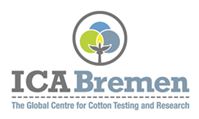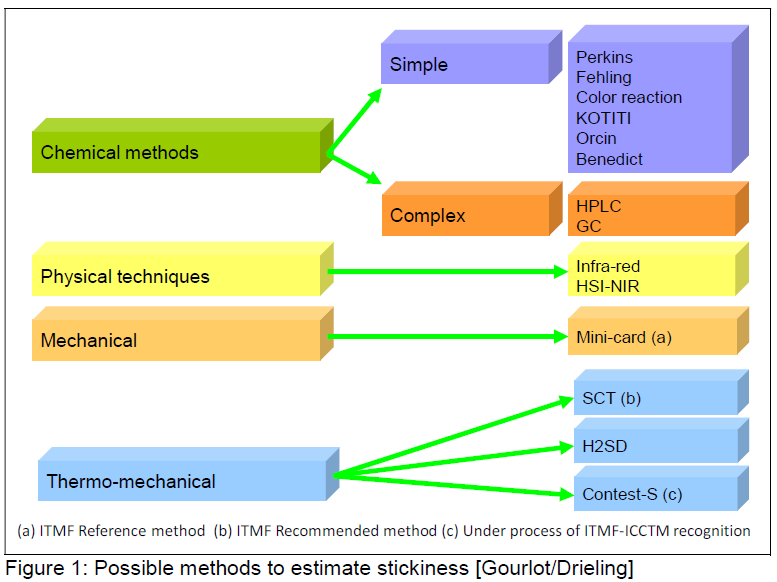 When present, stickiness causes drastic problems in processing and in yarn quality, hence it is important to evaluate the stickiness of cotton for trading.
When present, stickiness causes drastic problems in processing and in yarn quality, hence it is important to evaluate the stickiness of cotton for trading.
Based on their work in the ITMF International Committee on Cotton Testing Methods (ICCTM), the cooperation partners for the Stickiness Round Trial, CIRAD, Faserinstitut Bremen and ICA Bremen were  asked to summarize their findings so far with regard to the fact that ICA studies the option of implementing stickiness in trade rules.
asked to summarize their findings so far with regard to the fact that ICA studies the option of implementing stickiness in trade rules.
Feasible Measurement Methods for Trading Purposes
The main, but not the only source for stickiness is honeydew contamination, drops of mixed complex sugars on the fibres. There are several different methods and methodologies for determining ![]() stickiness. They can be divided into chemical methods, physical techniques, mechanical and thermo-mechanical methods. Due to their different methods and specific sensitivity and influences, they produce different test results and are therefore not completely interchangeable. For any commercial purpose, one suitable test method or few clearly defined test methods have to be determined.
stickiness. They can be divided into chemical methods, physical techniques, mechanical and thermo-mechanical methods. Due to their different methods and specific sensitivity and influences, they produce different test results and are therefore not completely interchangeable. For any commercial purpose, one suitable test method or few clearly defined test methods have to be determined.
All test methods have to deal with the problem that different kinds of sugar show an extremely different stickiness potential. The measurement of the sugar content or its chemical reaction only is absolutely insufficient. Complex chemical test methods (like HPLC) as well as physical techniques (like HIS-NIR) do not seem to be suitably developed for daily testing in a trading context, and the mechanical mid-card testing is too slow and too variable.
 The mechanical and thermo-mechanical methods show the best correlation between stickiness test results, processing behaviour and yarn quality. Hence, solely thermo-mechanical methods should be used for the evaluation of the stickiness potential and seem to be suitable for trading purposes.
The mechanical and thermo-mechanical methods show the best correlation between stickiness test results, processing behaviour and yarn quality. Hence, solely thermo-mechanical methods should be used for the evaluation of the stickiness potential and seem to be suitable for trading purposes.
Variations in Stickiness Test Results
Another problem is the variation in stickiness test results. As there are „nests“ of stickiness on the fields and consequently in the bales, a sample cannot be fully representative for the complete bale, which is a problem for sampling. There are variations of test results within a sample, within a bale and within a lot.
Test results show that the variation between different instruments and laboratories is very high in general. In contrast, the correlation between the different mechanical and thermo-mechanical test methods has proven to be good compared to other methods. A suitable correlation between the thermo-mechanical test methods and the Mini-card as the ITMF reference method is given.
This leads to the conclusion that solely thermo-mechanical test methods should be used for trade purposes. At this stage there is no thermomechanical test method that should be prioritized due to better correlations or excluded due to worse correlations. The SCT, the H2SD and the Contest-S are the methods of choice.
We are currently looking at ways of developing a Common Stickiness Scale for all three methods in order to harmonise the different stickiness scales. The results of each method will be translated to this scale.
Further Research and Collaboration necessary
It is important to continue inter-laboratory tests as well as research for evaluating the relationship between stickiness test results and stickiness in spinning practice and try to find thresholds for stickiness impact on spinning.
In addition, it is recommended that laboratories that are included in cotton trading are regularly checked and compared (Stickiness Round Trials). In this regard it would be helpful to analyse sources of result variabilities and systematic deviations as well as to develop suitable stickiness calibration material and a testing guideline.
Trade rules for the sampling of bales, for testing, and regulations for measurements will have to consider the specific problems of stickiness, especially the high variation of stickiness test results.
Read the original article ‘Use of Stickiness Test Results for for Trading Purposes’

